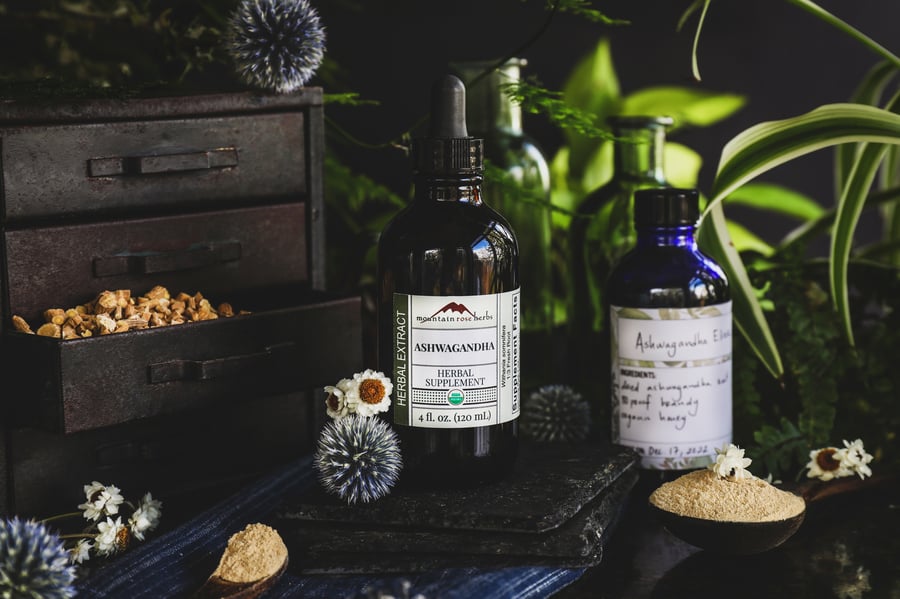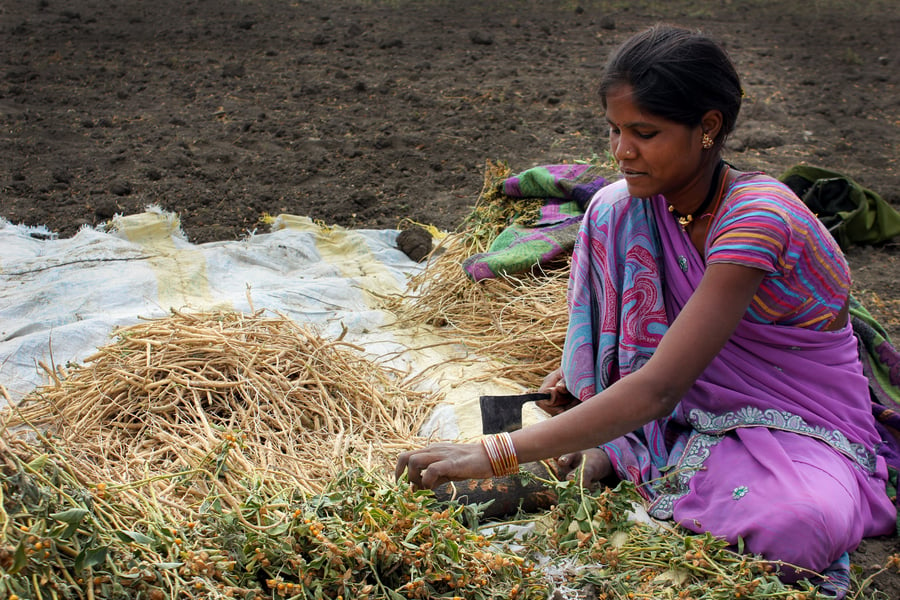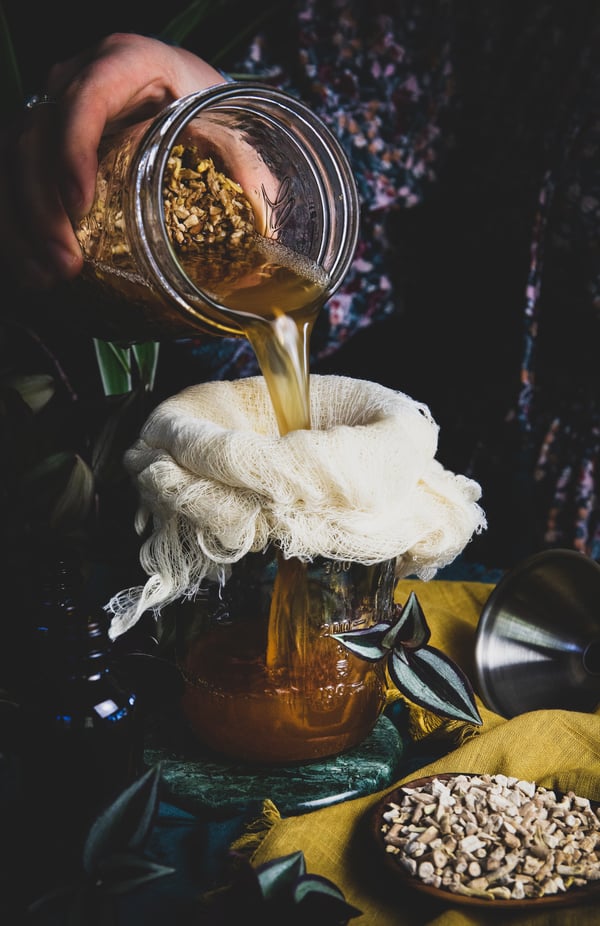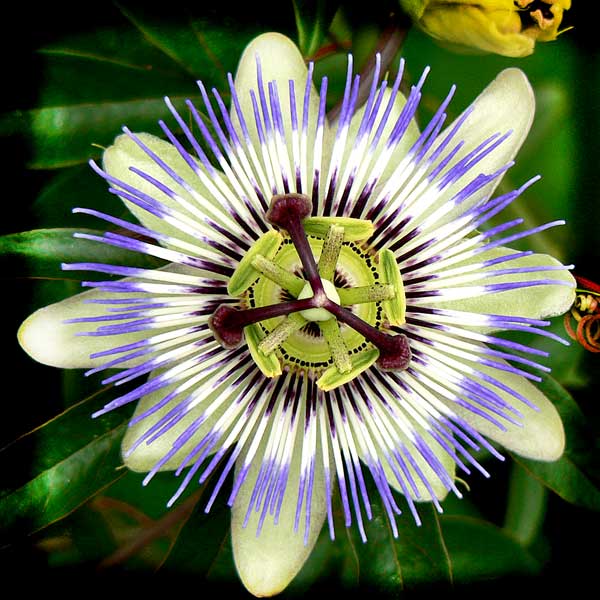
Ashwagandha (Withania somnifera) a plant highly praised in the Ayurvedic tradition, is in the Solanaceae, or nightshade, family. It’s been said that the herb may give both energy and calmness to those plagued with physical, mental, and emotional exhaustion. The species name somnifera means sleep-inducing, whereas ashwagandha comes from the Sanskrit words “ashva” and “gandha,” meaning “horse smell” since some think the roots of this calming plant smell like a horse. To each their own in the smell department; however, being a trophorestorative herb, it can bring “horselike” strength and vitality when used consistently over time. Ashwagandha has also been known to have a positive effect on cortisol levels due to real and perceived stress triggers and their subsequent physical and emotional symptoms. With stress being a way of life for many, the release of stress may also result in increased vigor and energy.
Working With Ashwagandha
One September a few years ago, I received a phone call from a woman who said she was the farm manager at a local organic farm and that they had planted a test patch of ashwagandha to see how easily it grew. As they were not going to use it that year, she asked if my apprentices would like to come out and harvest the ashwagandha in trade for my taking her crew up into the mountains for a wildcrafting adventure. Talk about a win/win. My apprentices and I had a lovely day on the farm. It was sunny and warm, so we toured the farm, which included potting sheds, chickens, picture-perfect rustic barns, and exquisite garden areas. My apprentices cut back the ashwagandha and dug up the roots. We ended up with a five-gallon bucket filled with dusky-smelling roots. We processed the roots barehanded, which meant that as we were cutting and chopping, the peaceful quality of ashwagandha was able to enter our bloodstream through our skin and infuse us with calm and serenity. At one point, I felt that peace that we all crave, and, sitting back, I took in the smiles on my apprentices’ faces and listened to their conversations and laughter. That, my friends, is the medicine of ashwagandha.
It can be a revelation when we come to understand that what others think of us is none of our business. If we have someone in our life whom we respect, perhaps some contemplation of their words is warranted, but in the end, we make the choices of how we live our lives. Everyone has their perspective and, while it may be true for them, it may not be true for us. There is a peace in allowing ourselves to hear what people say objectively and yet not take it as personal criticism. What people think about us does not necessarily warrant action on our part. When we feel hemmed in by others’ judgments, peace is just a thought away. We can change our thoughts. We can learn to let go. Ashwagandha can help.
Given that ashwagandha and tobacco are in the same family, it’s no surprise that ashwagandha roots contain small amounts of nicotine. Nicotine releases dopamine, a neurotransmitter that plays a role in how we feel pleasure. The alkaloids somniferine, visamine, and withsomnine are hypnotic sedatives. Sitoindosides, sterol lipids, in the plant have stress relieving actions and increase mobilization and activation of macrophages which helps to stimulate the immune system.
Caution: While it may seem like ashwagandha is a miracle herb, please take note that it can potentiate (increase the effects of) certain barbiturates. It’s also contraindicated during pregnancy as it can cause miscarriage. Additionally, those who have a sensitivity to nightshades such as tomatoes, potatoes, and peppers may have the same sensitivity to ashwagandha.
Ashwagandha in the Garden
When we spend quiet meditative time in the garden, we enter into a conversation with the soil, plants, insects, birds, and all that resides there. In nature, there is no “he said, she said,” no guilt or worry, no seeking of approval, or doubts about self-worth. No one is regretting what happened before or wondering what is to come. It seems that, in nature, everything just “is.” We all have the supreme opportunity to exist in that fashion just as the rest of nature’s inhabitants do if we so choose. And, if only for a short time, it brings us back to who we really are.
Grow ashwagandha in a sunny location in the ground or planter. Spend time with it during its growing season and feel the deep peace that nature provides. Digging ashwagandha roots in the early fall is both grounding and relaxing. Take the time to work slowly and meditatively. Enjoy the feel of the soil between your fingers; celebrate the triumph of harvesting and washing the roots. Next, dry the roots and store them in a glass jar until ready to use.
Palatable Preparations
It's important to have options available for those who can't or don't wish to use alcohol, find the taste of teas unpleasant, or are new to herbalism and may be hesitant. Ashwagandha Whipped Cream is a real crowd-pleaser and certainly brings the supportive qualities in a tasty and easy-to-enjoy way.
Ashwagandha Whipped Cream
Ingredients
- 2 cups organic whipping cream
- 1 Tbsp. ashwagandha root powder
- 1-2 Tbsp. organic maple syrup
Directions
- Whip the cream in a cold bowl until it begins to froth.
- Add the ashwagandha root powder and maple syrup. Continue to whip just until stiff peaks appear.
- It will keep in the fridge for up to a week.
To Use: While we would never eat a whole pint of whipped cream (or would we?), a tablespoon or two will be all that’s needed to feel ashwagandha’s calming effects. Ashwagandha whipped cream also tastes lovely in tea.
Pro Tip: Don’t whip the cream too much or you’ll get ashwagandha butter. That wouldn’t necessarily be a bad thing, but the usage would be different.
Ashwagandha Elixir
An elixir uses the extracting and preserving properties of honey and alcohol to make a preparation that can contain the full complement of nutrients and beneficial properties of a plant. Some herbalists use equal parts of honey and alcohol. I prefer using two parts alcohol and one part honey. The strength of the elixir will be the same, but the result will have a lower sugar content.
Ingredients
- 1/3 cup dried organic ashwagandha root or 3/4 cup minced fresh ashwagandha root
- 80-proof Brandy
- Honey
Directions
- Place ashwagandha root in an 8 oz jar.
- Pour in brandy so that it fills 2/3 of the jar, then add honey until it reaches the top of the jar.
- Put on a lid and label. Include name of formulation (ashwagandha elixir), the menstruum you used (80 proof
brandy and honey), and the date it was made. It is also important to add what the remedy is used for. That
really comes in handy when in a stressed situation. Reading a label that says “relieves stress” is much easier to comprehend than wondering what the herb can be used for. - Let the jar sit on your counter for 3 weeks, then strain.
- Pour the ashwagandha elixir in 1 oz. dropper or spray bottles to carry with you. Just a few drops or sprays can be calming. Take as needed.
Now you have more tools in your herbal tool belt. Good on ya! I leave you Wild About Plants.
WANT TO LEARN MORE FROM SUZANNE TABERT?
Explore Cedar Mountain Herb School!
You may also enjoy
The Benefits & Uses of Lemon Balm
Flavored Vegan Whipped Cream Recipe
Stinging Nettle Identification, Benefits, & Recipes
*These statements have not been evaluated by the Food and Drug Administration. These products are not intended to diagnose, treat, cure, or prevent any disease. We recommend that you consult with a qualified healthcare practitioner before using herbal products, particularly if you are pregnant, nursing, or on any medications. For educational purposes only.












